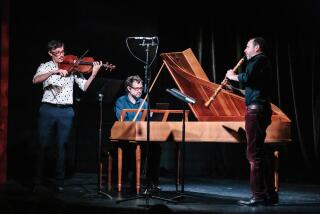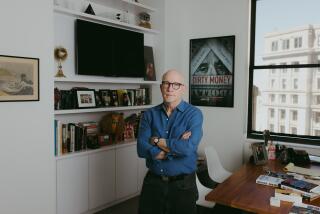The Edge of Note
- Share via
Call it a semirural appendage to the metropolis if you must, but Ventura County enjoys the distinction of being home to artists and musicians who benefit from the environment here, and vice versa. Two new recordings, released by Venturans past and present, exemplify the level of artistry that Ventura can call her own.
There may be little on the surface that would link the CD by Ventura-based classical composer John Biggs and the album called “Lan Xang,” a potent jazz concoction led by Ventura-bred and now New York-based saxophonist Dave Binney. But both cling fiercely to creative evolution, making music that bows to no commercial muse. Here are fine examples of music for music’s precious sake, in their respective genres.
Both albums also share the distinction of having been created outside usual music-industry channels. Biggs’ music was recorded in the Czech Republic in 1996, performed by the Moravska Filharmonie Olomouc featuring gifted Czech soloists, and released on the MMC label. Binney, who has played in numerous jazz groups and continues to record for different labels, has gone the do-it-yourself route by starting his own small label, Mythology Records.
The Biggs project is especially significant in that it offers a strong document of the gifts of a composer whose music has often been commissioned and heard in recent years in Ventura County.
At the risk of trying to reduce original music to the sum of its influences, Biggs’ three works here evoke parallels to the work of three major 20th century figures--Bela Bartok, Aaron Copland and Igor Stravinksy. What this lineage of musical influence demonstrates is not an apish attempt to borrow from the best, but Biggs’ historical savvy and his ability to create within a framework of agreeable modernism.
The Concerto for Oboe, premiered in 1958, bears signs of folkish modernism, while tonal tension and bounding idealism mark the harmonic palette of the Concerto for Violin and Classical Orchestra, written for violinist Nina Bodnar and premiered in 1988. Finally, touches of Stravinsky resonate through Biggs’ Triple Concerto, premiered in 1962.
Throughout, Biggs’ assured musical voice rings through.
Fringe Jazz Maneuvers: Binney’s group Lan Xang formed in 1994 but make their debut recording with the new Mythology album. The band is a kind of all-star, chordless quartet, with Binney and tenor saxist Donny McCaslin joined by noted drummer Jeff Hirshfield and bassist Scott Colley. Each player is commanding and creatively limber enough to make for a full, varied group sound, in which the lack of a chordal instrument isn’t even an issue.
Binney, one of the more inventive alto saxophonists on the jazz scene, keeps busy with various groups and has a growing discography as a leader. He is a founding member of the post-fusion group Lost Tribe, which released its first album on Windham Hill, produced by Walter Becker, and will be coming out with a new one in February on the Arabesque label.
As a unit, Lan Xang avoids any obvious stylistic camps, but deftly mixes bebop, free jazz and contemporary chamber music into a sound that makes its own logic. There are somber moments, but also humor and kinetic energy, as on the quirky post-bop of “Rob Petry” or the funk-lined swagger of “2nd Line Sally”--tunes written by McCaslin.
On the album, Binney shows his own compositional aplomb and flexibility, from the handsome melodiousness of “Day of Fear, Night of Truth,” to the saw-toothy charm and intricate horn voicings of “Tango, Waltz and Variations on . . . “ All in all, Lan Xang emerges as a project both introspective and feisty, taking jazz instincts in a new direction.
Future recordings on Binney’s Mythology label will include an album by the bold young pianist Edward Simon, with whom Binney also plays. Distribution is pending, but the album is available via mail-order, from 6180 Via Real No. 2, Carpinteria, CA 93013, or by calling (888) 684-2968.
More to Read
The biggest entertainment stories
Get our big stories about Hollywood, film, television, music, arts, culture and more right in your inbox as soon as they publish.
You may occasionally receive promotional content from the Los Angeles Times.










